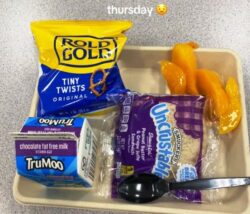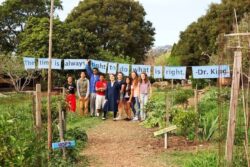Read Time: 5 Minutes Subscribe & Share
Disease on a Tray
 While researching these Kitchen Detail posts on school lunches — not only in the U.S. but abroad — the lunch landscape on my former turf looked exceedingly grim. I remembered a dismal conversation I once had with a prominent D.C. chef who had been asked by a local school district about a decade ago to advise them on improving their lunch program. Until then, I hadn’t realized how the certification and funding for school lunches actually worked. He recently wrote to me about his experience:
While researching these Kitchen Detail posts on school lunches — not only in the U.S. but abroad — the lunch landscape on my former turf looked exceedingly grim. I remembered a dismal conversation I once had with a prominent D.C. chef who had been asked by a local school district about a decade ago to advise them on improving their lunch program. Until then, I hadn’t realized how the certification and funding for school lunches actually worked. He recently wrote to me about his experience:
“I was approached by a small school system in the Washington, D.C. area to look at their school lunch program. It had two elementary schools, one preschool, one middle school, and one high school. Of the four, only one had a fully functional kitchen. The rest could do little more than heat and serve meals.
“The real shock came when I learned how schools received their federal lunch funds. Instead of cash, they got a catalog — a phonebook-sized listing of mostly processed, frozen foods they could order. Almost no whole foods. I was told the federal program evolved to absorb surplus commodities from federal farm programs. If a school system didn’t want food from the catalog, it lost its federal benefit.
“So kitchens disappeared — they weren’t needed. In the district I visited, one central kitchen acted as the commissary for the others (though it didn’t have much to do). It was demoralizing. The call for better school lunches keeps colliding with other government programs. Want vegetables? Have some ketchup.”
There’s Some Good News
At this point, I feel a bit like Gabriel Heatter, the radio newscaster in the 1940s and 50s who insisted on finding optimism amid the gloom of World War II. He began every broadcast with: “Good evening, everyone — ah, there is good news tonight.” You may recognize his name — he was the father of Maida Heatter, my earliest baking mentor through her books like Maida Heatter’s Great Desserts. She made many of us beginning bakers so happy with her marvelous cakes, cookies and frozen desserts (Her Rum Raisin Ice Cream recipe is a knockout). And she definitely inherited her father’s optimism gene — though she channeled it into chocolate mousse and brownies, not battlefronts.
finding optimism amid the gloom of World War II. He began every broadcast with: “Good evening, everyone — ah, there is good news tonight.” You may recognize his name — he was the father of Maida Heatter, my earliest baking mentor through her books like Maida Heatter’s Great Desserts. She made many of us beginning bakers so happy with her marvelous cakes, cookies and frozen desserts (Her Rum Raisin Ice Cream recipe is a knockout). And she definitely inherited her father’s optimism gene — though she channeled it into chocolate mousse and brownies, not battlefronts.
So, yes, there is good news tonight.
Since those scary photos of cafeteria trays (remember Fed Up With Lunch? — we sold it in the shop), several grassroots and national efforts have begun to change how we think about feeding children in schools. Here are three that truly made a difference:
several grassroots and national efforts have begun to change how we think about feeding children in schools. Here are three that truly made a difference:
1. The Edible Schoolyard Project (1995) Alice Waters launched this program in Berkeley, California, when a local middle school decided to grow its own organic garden and cook fresh, healthy meals in-house. The project linked students and teachers with local farmers and taught sustainable agriculture. Now celebrating its 30th year, the Edible Schoolyard Project has almost 6,000 affiliates in the U.S. and 75 programs around the world.
Alice Waters launched this program in Berkeley, California, when a local middle school decided to grow its own organic garden and cook fresh, healthy meals in-house. The project linked students and teachers with local farmers and taught sustainable agriculture. Now celebrating its 30th year, the Edible Schoolyard Project has almost 6,000 affiliates in the U.S. and 75 programs around the world.
2. Two Angry Moms (2007)
This movement began when two very fed-up mothers turned their frustration into a documentary and activist guide to push back against USDA-funded junk-food lunches. Their grassroots efforts helped parent groups across the country demand better food in their school districts — and some succeeded in altering individual school meal choices.
3. The Let’s Move Initiative (2010)
First Lady Michelle Obama’s campaign to tackle childhood obesity evolved into the Healthy Hunger-Free Kids Act. It revamped federal nutrition standards, made school lunches healthier and more accessible, and replaced the carb-heavy, Big-Ag-influenced Food Pyramid with the MyPlate model: half fruits and vegetables (with more vegetables than fruit), a quarter grains (mostly whole), a lesser quarter protein, and a smaller serving of dairy. A dessert allotment is not included.
Today, these initiatives — once separate and scrappy — are reflected in how many school districts approach food. In my old hometown of Alexandria, Virginia, a local high school has become something of a model: meals are cooked in-house, menus are varied and nutritious, and students are encouraged to make healthier choices. (You can watch the story here — it’s worth the three minutes.)
Across the country, a quiet revolution is underway.
Hawaii leads the nation in “farm-to-school” participation, with an astonishing 99% of its schools sourcing locally. Students visit the farms that grow their lunches — and sometimes even maintain school gardens themselves. Vermont, Virginia (yay!), West Virginia, and Delaware also have high rates of local sourcing, while Washington, D.C., Rhode Island, and Oregon report over 80% participation.
Surprisingly, Alaska tops the list for serving the most fresh fruits and vegetables in its school meals, and Vermont leads the nation in school gardens — nearly 40% of its schools maintain one.
But there are still gaps. States like Oklahoma, Mississippi, South Dakota, Alabama, and Missouri rank lowest in farm-to-school programs and access to fresh produce. The divide between “real food” and “commodity food” remains a stubborn line drawn by funding, geography, and politics.
A Better Menu Ahead
So yes — there’s still disease on a tray, but also promise in the garden. From ketchup-as-vegetable absurdities to kale growing outside the cafeteria door, progress is slow, perhaps patchy, but visible. If the lunch tray once symbolized everything wrong with industrialized food, maybe — just maybe — it’s starting to carry something healthier: local tomatoes, fresh bread, and a lesson that good food isn’t a privilege, but a right. If we someday get all that right, maybe we can have dessert.

Kitchen Detail shares under the radar recipes, explores the art of cooking, the stories behind food, and the tools that bring it all together, while uncovering the social, political, and environmental truths that shape our culinary world.




“Good food isn’t a privilege, but a right.” Here here! My sixth-grade English teacher at Thomas Jefferson Middle School, alas, wouldn’t have agreed. His class, which took place right before lunchtime, sometimes ran so late that we missed lunch entirely. When a student meekly protested this injustice, he bellowed: “Lunch is not a right; lunch is a privilege!” He sure taught us coddled Arlingtonians a thing or two!
Now that we live in Hawaii, we buy all our produce at farmers’ markets. Kids are actively involved and can answer questions we have about their family’s products. Kaua’i is our new home.
Nancy, thank you for the promising story. The link to ACHS is very interesting, considering I graduated from there under its previous name, in 1972. Real food was prepared for lunches then. Now it appears they are offering some again.
Let’s hope the tide rises to encourage more schools to do the same, and perhaps like ACHS , offer culinary classes as well.